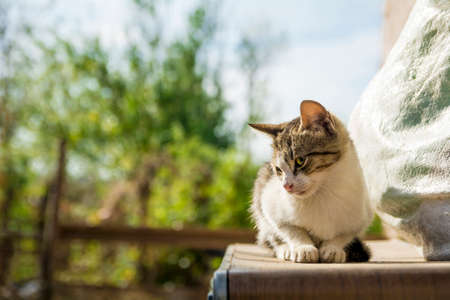Understanding Your Cat’s Outdoor Habits
Before you begin the process of transitioning your outdoor cat to a comfortable indoor lifestyle in a British home, it’s essential to understand their current habits and routines. Many British cats enjoy roaming gardens, exploring hedgerows, and patrolling familiar neighbourhoods. Take time to observe your cat’s daily patterns—do they venture out at dawn for a stroll along garden fences or spend afternoons sunbathing on the patio? Noting these details helps you recognise what aspects of their outdoor adventures bring them joy. Consider the size of their territory: do they stick close to your property or wander further afield, perhaps visiting friendly neighbours or favourite green spaces? Understanding their typical activities—such as hunting, climbing trees, or socialising with other local cats—will provide valuable insights into their needs and preferences. This assessment is the first step towards creating an enriching indoor environment that reflects the freedoms and comforts your cat has grown accustomed to in the great British outdoors.
Preparing Your British Home for Indoor Life
Transitioning your outdoor cat to an indoor lifestyle in a British home requires thoughtful preparation. Cats are curious creatures, and a sudden change in environment can be unsettling, especially if theyre used to roaming the garden or exploring the local allotments. The key is to create an environment that feels both secure and stimulating, while also reflecting the unique characteristics of a British household.
Cat-Safe Furnishings
First, consider your furniture and décor. Opt for sturdy, easy-to-clean materials—many UK homes feature carpets, but if you’re refitting, vinyl or laminate flooring can make cleaning up after muddy paws much simpler. Cover sofas with washable throws sourced from local shops like John Lewis or Marks & Spencer. Avoid trailing cords from lamps or blinds, as these can be tempting for playful felines.
Enrichment Zones
Cats need dedicated spaces to express their natural behaviours. Create enrichment zones with scratching posts (preferably made from sustainable British wood), climbing trees, and hidey-holes. Place these near windows so your cat can watch the world go by—British wildlife like robins and hedgehogs will provide endless entertainment! Rotate toys regularly and include puzzle feeders sourced from UK pet retailers to keep your cat mentally stimulated.
Table: Enrichment Essentials for British Homes
| Item | UK Source | Purpose |
|---|---|---|
| Scratching Post | Pets at Home | Claw maintenance & stress relief |
| Puzzle Feeder | Zooplus UK | Mental stimulation & slow feeding |
| Window Perch | Amazon UK | Birdwatching & relaxation spot |
British Household Considerations
The typical British home has features you’ll want to address for safety. Check all windows: older sash styles may not have secure locks, so fit window restrictors or screens to prevent escapes. Fireplaces should be blocked off when not in use—cats love squeezing into nooks. If you have a conservatory or utility room, transform it into a sunbathing area with cosy beds and safe plants (avoid lilies and foxglove, which are toxic).
Using Local Products for Comfort and Familiarity
Support local businesses by choosing British-made bedding and toys—these often use natural materials that are gentle on sensitive paws. Incorporate scents familiar from outdoors by using lavender sachets (out of reach) or potted cat grass from the garden centre.
A well-prepared indoor environment makes the transition smoother for both you and your feline friend, ensuring they feel right at home—even when the weather outside is proper British drizzle!
![]()
3. Introducing Indoor Routines and Enrichment
Transitioning an outdoor cat to indoor life within a British home requires more than just shutting the door—it’s about replicating the rich variety of sights, smells, and activities your cat once enjoyed in the garden or on neighbourhood strolls. Establishing engaging indoor routines is key. Begin by setting regular meal times, play sessions, and quiet periods throughout the day; British cats thrive on predictability. Use interactive toys that mimic local wildlife—think feather wands resembling blackbirds or plush mice echoing those from the hedgerow. Rotating toys weekly keeps things fresh, preventing boredom and stimulating your cat’s natural hunting instincts.
Environmental enrichment is equally essential. Position perches near windows so your cat can observe the comings and goings of village life, watch birds fluttering in the garden, or simply bask in a sunbeam. Consider introducing cat-safe houseplants like wheatgrass or valerian for nibbling, echoing the greenery of a British back garden. Puzzle feeders filled with treats can mirror the challenge of foraging outdoors, while cardboard boxes or paper bags offer opportunities for exploration reminiscent of darting through shrubs or garden sheds.
For even greater stimulation, try scent games using items found in your local area—a sprig of lavender from the allotment or a handful of autumn leaves from a nearby park. These familiar scents provide comfort and intrigue, helping your cat adjust to their new indoor territory while maintaining a tangible connection to their beloved British outdoors.
Managing Behavioural Challenges
Transitioning an outdoor cat to the comforts of a British home can sometimes feel like inviting a little wild spirit indoors. Cats accustomed to roaming the garden, chasing birds, or sunning themselves on the patio may show certain behaviours that prove challenging in a domestic setting. Recognising these issues and offering UK-acclimatised solutions is key to a harmonious transition.
Common Indoor Behavioural Issues
| Behaviour | Description | British-Style Solutions |
|---|---|---|
| Door-dashing | Cat tries to bolt outdoors whenever a door opens | Use double-door entryways common in British homes, install baby gates, provide window perches for safe outdoor views |
| Scratching furniture | Clawing at sofas or carpets instead of trees or fences | Offer sisal scratching posts, cardboard scratchers, or carpet offcuts; sprinkle with catnip or rub with rosemary from your British garden |
| Boredom-related mischief | Over-grooming, knocking items over, or vocalising out of boredom | Rotate interactive toys, puzzle feeders, and create indoor ‘catios’ with potted lavender or mint for familiar British scents |
Redirecting Outdoor Instincts Indoors
Cats may miss the stimulation of outdoor life. To counteract this, enrich their indoor environment by bringing some of the British countryside inside. Place pots of cat-safe herbs like catmint, valerian, or wheatgrass on windowsills. You could even bring in branches or leaves from your garden for supervised play sessions. This not only provides scent enrichment but also offers tactile experiences reminiscent of their old stomping grounds.
Scratch-Friendly Zones
Set up dedicated areas where scratching is encouraged and rewarded. Position sturdy scratching posts near favourite lounging spots and entrances—much like a fencepost by the garden gate. If your cat targets particular furniture, temporarily cover those areas with double-sided tape or foil (both widely available in UK supermarkets) while introducing more appealing alternatives nearby.
Consistency Is Key
The shift from outdoor adventurer to cherished housecat takes patience and consistency. Use gentle redirection rather than punishment; if your feline friend makes a dash for the door or sharpens her claws on the settee, calmly lead her to an appropriate activity or object. Over time, positive reinforcement and plenty of mental stimulation will help your cat embrace indoor living in true British style.
5. Ensuring Physical and Mental Wellbeing
Transitioning your cat from an outdoor adventurer to an indoor companion in a British home requires thoughtful attention to their physical and mental wellbeing. The change in environment means revisiting your cat’s diet, exercise routine, and access to veterinary care, all within the context of UK living.
Reviewing Your Cat’s Diet
Indoor cats typically burn fewer calories than their outdoor counterparts, so it may be necessary to adjust portion sizes or switch to a specially formulated indoor cat food available from most British supermarkets or pet shops. These foods often contain higher fibre for digestive health and fewer calories to help prevent weight gain. Always ensure your moggy has access to fresh water, especially if you’re feeding dry kibble.
Exercise: Keeping Your Cat Active Indoors
One of the main challenges is mitigating the loss of natural exercise that comes with roaming gardens and alleyways. In a British home, provide stimulating toys such as feather wands, laser pointers, and interactive puzzle feeders. Set aside daily play sessions—cats love routine, so a few minutes after tea time can become a cherished part of their day. Consider investing in scratching posts and cat trees that allow vertical exploration, mimicking the climbing opportunities found outdoors.
Environmental Enrichment
Window perches can offer your cat a view of the neighbourhood birds or passing posties, keeping them mentally engaged. Some British households even set up ‘catios’—enclosed patios or balconies—to give their pets a safe taste of the outdoors. Rotate toys regularly and hide treats around your flat or house to encourage natural hunting behaviours.
Routine Vet Care in the UK
Indoor cats still require regular check-ups at your local vet’s surgery. Annual vaccinations, flea and worm treatments, and dental checks are just as important indoors as out. If you’re not already registered with a nearby practice, now’s the time; ask about pet insurance options popular in Britain for peace of mind against unexpected vet bills.
Monitoring Behavioural Health
The transition can occasionally lead to stress or boredom-related behaviours such as over-grooming or scratching furniture. Keep an eye out for changes in appetite or mood, and don’t hesitate to consult your vet if you notice anything amiss. Using pheromone diffusers like Feliway—widely available at UK pet stores—can help ease anxiety during this period.
A Holistic Approach
Ultimately, meeting your indoor cat’s physical and mental needs will ensure they remain healthy and content in their new life inside your British home. With attentive care tailored to UK living standards, your feline friend can thrive just as happily on the sofa as they once did in the garden.
6. Balancing Safety and Freedom
Transitioning your beloved moggy from the wilds of the British outdoors to the safety of indoor living doesn’t mean they have to lose all sense of adventure. Many UK cat guardians are now opting for inventive ways to keep their cats stimulated, while ensuring they remain out of harm’s way. A popular British solution is the ‘catio’—an enclosed patio or balcony specifically designed for feline explorers. These structures allow cats to experience fresh air and watch garden wildlife without the risk of traffic, foxes, or other dangers typical in UK neighbourhoods. If a full catio isn’t practical in your home, window perches are another fantastic option. By installing a secure perch or hammock near a sunny sash window, you can provide your cat with hours of entertainment as they observe birds and neighbours passing by. For those with private gardens, supervised outings can also be considered. In true British fashion, pop on a raincoat and let your cat explore on a harness and lead, always keeping a watchful eye out for local hazards like hedgehogs or busy roads. With these tailored solutions, you strike a perfect balance between safety and freedom, catering to your cat’s natural instincts within the unique context of British homes and gardens.
7. Building a Lasting Bond Indoors
Transitioning your outdoor cat to indoor living in a British home isn’t just about providing shelter and entertainment—it’s also the perfect opportunity to cultivate a deep, lasting bond. Cats, especially those used to their independence outdoors, may take some time to fully trust and connect with you in an indoor environment. Patience is absolutely key here; allow your cat to come to you on their terms and resist the urge to rush interactions.
Positive Reinforcement: The British Way
British cat lovers know that a gentle approach works wonders. Use positive reinforcement—offer tasty treats (perhaps a bit of chicken or high-quality kibble), soothing words, and plenty of strokes when your cat displays calm or curious behaviour indoors. Consistency in rewards helps your cat associate indoor life with safety and pleasure, making them more likely to seek out your company.
Quality Time Together
Spending meaningful time together is crucial for strengthening your relationship. Dedicate daily moments to interactive play using feather wands, toy mice, or even homemade toys crafted from common British household items like scrunched-up paper or cardboard boxes. Curl up with your cat during quiet evenings—perhaps while enjoying a cup of tea—and let them settle beside you as you read or watch telly. These small rituals can become treasured routines for both of you.
Respect Their Personality
Every cat has a unique character, shaped by their experiences outdoors and their new life indoors. Some may relish cuddles on the sofa, while others prefer observing from a sunny windowsill. Respect these preferences and celebrate the little milestones—whether it’s the first head bump or a playful pounce in the hallway.
By nurturing trust through patience, positive reinforcement, and shared activities within your British home, you’ll not only help your former outdoor cat adapt but also build a loving companionship that enriches both your lives for years to come.


